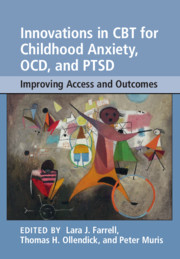Book contents
- Innovations in CBT for Childhood Anxiety, OCD, and PTSD
- Innovations in CBT for Childhood Anxiety, OCD, and PTSD
- Copyright page
- Contents
- Figures
- Tables
- Contributors
- Preface
- Acknowledgments
- Part I Anxiety Disorders
- 1 Phenomenology and Standard Evidence-Based Care of Anxiety Disorders in Children and Adolescents
- 2 Evidence-Based Assessment
- 3 Self-Help Treatment of Childhood Anxiety Disorders
- 4 New Technologies to Deliver CBT
- 5 Cognitive Bias Modification Strategies for Anxious Children
- 6 Brief Intensive Treatments
- 7 Pharmacologic-Enhanced Approaches for the Anxiety Disorders
- 8 Enhanced Family Approaches for the Anxiety Disorders
- 9 Treatment of Comorbid Sleep Problems in Anxious Children
- 10 Transdiagnostic Approaches to the Treatment of Anxiety Disorders in Children and Adolescents
- 11 Dissemination and Implementation of Evidence-Based Programs for the Prevention and Treatment of Childhood Anxiety
- 12 Innovations in the Treatment of Childhood Anxiety Disorders
- Part II Obsessive-Compulsive Disorder
- Part III Post-Traumatic Stress Disorder
- Index
- References
8 - Enhanced Family Approaches for the Anxiety Disorders
from Part I - Anxiety Disorders
Published online by Cambridge University Press: 12 April 2019
- Innovations in CBT for Childhood Anxiety, OCD, and PTSD
- Innovations in CBT for Childhood Anxiety, OCD, and PTSD
- Copyright page
- Contents
- Figures
- Tables
- Contributors
- Preface
- Acknowledgments
- Part I Anxiety Disorders
- 1 Phenomenology and Standard Evidence-Based Care of Anxiety Disorders in Children and Adolescents
- 2 Evidence-Based Assessment
- 3 Self-Help Treatment of Childhood Anxiety Disorders
- 4 New Technologies to Deliver CBT
- 5 Cognitive Bias Modification Strategies for Anxious Children
- 6 Brief Intensive Treatments
- 7 Pharmacologic-Enhanced Approaches for the Anxiety Disorders
- 8 Enhanced Family Approaches for the Anxiety Disorders
- 9 Treatment of Comorbid Sleep Problems in Anxious Children
- 10 Transdiagnostic Approaches to the Treatment of Anxiety Disorders in Children and Adolescents
- 11 Dissemination and Implementation of Evidence-Based Programs for the Prevention and Treatment of Childhood Anxiety
- 12 Innovations in the Treatment of Childhood Anxiety Disorders
- Part II Obsessive-Compulsive Disorder
- Part III Post-Traumatic Stress Disorder
- Index
- References
- Type
- Chapter
- Information
- Innovations in CBT for Childhood Anxiety, OCD, and PTSDImproving Access and Outcomes, pp. 182 - 205Publisher: Cambridge University PressPrint publication year: 2019
References
- 1
- Cited by



